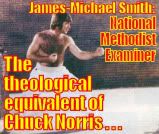1:1 The revelation of Jesus the Messiah, which God gave
him to show his servants what must take place soon/swiftly.
He made it clear by sending his angel to his servant John, 2 who then testified to everything
that he saw concerning the word of God and the testimony about Jesus the Messiah.
3 Blessed is the one who reads the words of this prophecy
aloud, and blessed are those who hear and obey the things written in it,
because the time is near!
4 From John, to the seven churches that are in the
province of Asia:
Grace and peace to you from
"the One Who is,"
and Who was,
and Who is coming,
and from the seven spirits who are
before His throne,
5 and from Jesus Christ–
the faithful witness,
the firstborn from among the dead,
the ruler over the kings of the
earth.
To the one who loves us and has set us free from our sins at the
cost of his own blood 6 and has appointed us as a kingdom, as priests serving
his God and Father--[to him] be the glory and the power for ever and ever!
Amen!
7 Look! He is coming with the clouds, (Dan. 7:13) and
every eye will see him, even those who pierced him (Zech. 12:10),
and all the tribes on the earth will mourn because of him.
Yes indeed! Amen!
says the Lord God–
the One Who is,
and Who was,
and Who is coming–
the All-Powerful!
--------------------------------------------
No.
The very first three words in the Greek text (the first six in English above) tell us specifically what is being “revealed” to John—Jesus the Messiah. Jesus is the subject of Revelation from beginning to end (or, if you like, from Alpha to Omega!). Jesus will shed light on everything that John and his readers find themselves undergoing at the tail end of the 1st century A.D. by showing them what the true nature of their then-current suffering actually entails—from a Heavenly perspective! In doing so, this revelation will make sense of all subsequent suffering followers of Jesus will undergo at the hands of those belonging to a world set against its true king.
Revelation offers more than just explanation, however. It offers exhortation. Those who listen to it read aloud in their gatherings each week (as well as the one reading it to them) are blessed not just by hearing things revealed, but by obeying them as well.
The threefold formula of vv.4-5 is extremely important for establishing a major theme that will weave itself throughout the book—the tri-unity of God Almighty. The greeting comes from “the One who is, and Who was, and Who is coming”—three ways of speaking of Yahweh, the God of Israel. The Divine name itself (YHWH in Hebrew) means “I Am.” John’s readers would’ve picked up on this as well as the other two titles’ (“the One Who was” and “the One Who is Coming”) Hebrew Bible resonances and would be clear that the first part of this greeting comes from Yahweh God Himself.
The second part (“the Seven Spirits before His throne”) has two possible referents. Some take it to refer to the 7 traditional archangels which in early Jewish thought were stationed before the throne of God (cf. Tobit 12:15 for example. The 7 angels traditional names, with some variation, are Uriel, Raphael, Raguel, Michael, Gabriel, Saiquael and Jeremiel. Only Gabriel and Michael are mentioned in the Hebrew Bible or New Testament however). This is possible, however, it is also possible that picking up on Isaiah 11:2’s seven-fold description of the Spirit of God and/or the symbolic meaning of the number 7 to denote completeness or totality, the “Seven Spirits” is a reference to the “Spirit of God” or what Christians know as the Holy Spirit.
The third part is explicitly referring to Jesus! (Interestingly, He is described as the “faithful witness”. This word “witness” (Greek: martys) is the legal term for one who provides testimony to something in a court setting. It is where our English word “martyr” comes from—precisely because the earliest persecuted Christians were often sentenced to death for testifying that Jesus, not Caesar, is Lord!).
God, Spirit, Jesus…speaking as One to the churches in Asia Minor through this vision given to John. The fullness of the Godhead—a concept that later theologians would label “the Trinity”—found right here alluded to in the beginning of Revelation.
V.6 also highlights a second theme that will dominate the book—that of all of God’s people being the fulfillment of “Israel.” Look at how John describes their identity:
This is language taken directly from Torah. Just as God “set free” ethnic Israel from Egyptian bondage at the Exodus, so too, through Jesus’ death and resurrection, He has “set free” true Israel from our slavery to Sin. And the promise that He would make His people a “kingdom” and “priests” to God (Exodus 19:6) was originally given to ethnic Israel. We now see that through the New Covenant this promise finds its fulfillment in all of God’s people—Jew and Gentile alike—who faithfully follow the Messiah. This may go against the teaching many of us have heard growing up, that there are “two peoples of God”—ethnic Israel and the Church. But it is one of the clearest messages taught throughout the New Testament. “Israel” has been expanded to include all who are in Covenant with God under the promised New Covenant (Ezekiel 36, Jeremiah 31, etc.).“To the one who loves us and has set us free from our sins at the
cost of his own blood and has appointed us as a kingdom, as priests serving his
God and Father…”







No comments:
Post a Comment